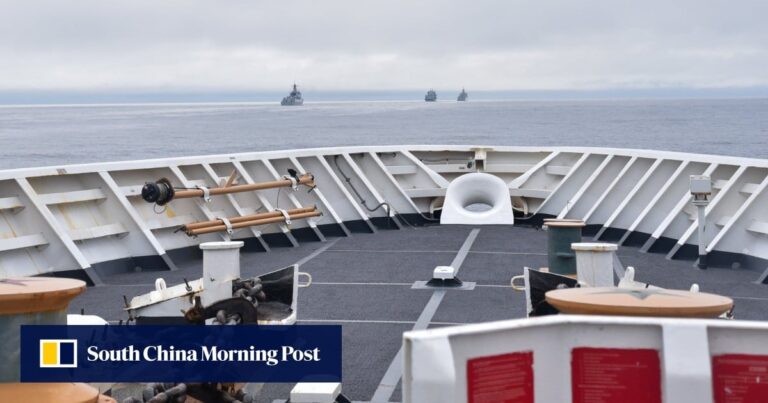In radio communications, the Chinese sailors claimed they were conducting a “freedom of navigation operation” and said the Coast Guard was watching the ship as it traveled south of the Aleutian Islands into the North Pacific Ocean to ensure it “does not interfere with U.S. interests in the maritime environment around Alaska.”
The latest sighting marks the fourth consecutive year that Chinese warships have been spotted in the region. In July 2023, Washington sent a destroyer near Alaska after the Chinese and Russian navies conducted joint patrols near the Aleutian Islands.
Troy Bouffard, director of the Arctic Security and Resilience Center at the University of Alaska Fairbanks, said Chinese warships are “rare” off Alaska’s coast because of historical maritime constraints that until recently limited Chinese activity mainly to coastal waters.
“However, the People’s Liberation Army (PLA) Navy has embarked on an ambitious trajectory to rapidly develop its blue-water capabilities, with a particular emphasis on naval power projection,” Bouffard said.
“This strategic shift is evident when it comes to operating within other countries’ EEZs. This approach not only marks an evolution of China’s maritime policy but also serves as a test of China’s expanding naval presence on the international stage.”
The sightings on July 6 and 7 came a week after the Chinese navy began joint patrols with the Russian navy in the Pacific Ocean, the latest in a series of annual patrols that began in 2021.
China’s Defense Ministry said Chinese and Russian naval vessels sailed in the western and northern Pacific Ocean and entered the South China Sea, where joint drills were being held on Sunday.
“The measure is not aimed at any third party and is unrelated to the current international or regional situation,” the ministry said in a statement.
Hu Bo, director of the Beijing-based think tank South China Sea Strategic Survey Initiative, said Chinese warships near Alaska have become more frequent.
“Chinese warships [near Alaska] “Although it is being carried out more frequently, this has not yet become the PLA’s regular practice,” Hu said.
He added that the voyage was “separate” from any joint patrols with Russia.
The Arctic region has attracted attention not only as a flashpoint between the United States and Russia as climate change melts the Arctic ice, but also for its strategic importance as a maritime link between the Asia-Pacific and Europe.
As a result, Alaska and the Bering Sea in the North Pacific have become important gateways to the Arctic Ocean.
Marc Lanteigne, an associate professor of political science at the Arctic University of Tromso in Norway, said the North Pacific has become “an arena for expanding Sino-Russian maritime cooperation” and that China is seeking to take advantage of closer strategic ties with Russia to increase its military presence.
“While Beijing has been cautious about expressing its Arctic policy in terms of hard power, Beijing is now more willing to demonstrate its capabilities for conducting military activities near the Arctic Ocean,” Lanteigne said.
While he said it was “highly unlikely” that China would launch a unilateral military presence in the Arctic, Beijing was interested in working with Moscow “to counter what it sees as U.S.-led and NATO-led attempts to expand the Western strategic agenda in the Far North.”
The sighting of Chinese vessels off the coast of Alaska drew four Asia-Pacific nations – South Korea, Japan, Australia and New Zealand – to a NATO summit in Washington last week.
Liselotte Odgaard, a senior fellow at the Hudson Institute, a Washington-based think tank, said China’s military cooperation with Russia is also a “major factor” in Moscow continuing to pose hard power threats to NATO allies in the Arctic.
She said her “real concerns” about close military cooperation between China and Russia in the Arctic are compounded by their economic and technological cooperation.
“[China has] Air, land, [and] Maritime transport. They also have space surveillance and polar satellites. [and] Odgaard said sharing data with Russia would improve situational awareness about sea ice movements and adversary nations.
“All of this could have military applications as well.”
“China wants to help [Russia] “China will continue to pose hard power threats to NATO because that will reduce Chinese pressure on the Asian mainland, where they are busy with other conflicts,” she said.
“China does not want to become a military power in the Arctic, but it feels that Western countries are becoming increasingly provocative and uncooperative and will show its support for Russia.”
Cameron Carlson, founding director of the Homeland Security and Emergency Management Program at the University of Alaska Fairbanks, said China’s positioning of itself as a “near-Arctic power” reflects its ambitions to take advantage of economic opportunities.
These include oil, gas and mineral extraction, as well as shorter maritime routes between Asia and Europe, he said.
“Cooperation with Russia will continue to further strengthen China’s military presence and surveillance capabilities in the Arctic, challenging U.S. influence and capabilities in the region.”
According to Carlson, the United States views China’s Arctic ambitions “with suspicion, particularly regarding potential military expansion and challenges to Arctic sovereignty.”
“The United States will strengthen its Arctic strategy by increasing its military presence and, hopefully, investing in Arctic infrastructure and capabilities. At the same time, it will strengthen alliances with other Arctic nations to counter China’s efforts to expand its influence,” he said.



